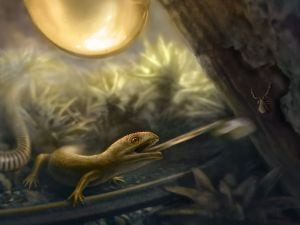Oldest evidence of slingshot-style tongue seen in 99m-year-old amphibians
Albanerpetontids were ‘sit-and-wait predators’ that snatched prey with a projectile firing of their ‘ballistic tongues’.

Scientists have uncovered the oldest evidence of a slingshot-style tongue in fossils of “weird” 99 million-year-old amphibians.
Researchers say these armoured creatures, knowns as albanerpetontids, were “sit-and-wait predators” that snatched prey with a projectile firing of their “ballistic tongues”.
Although they had lizard-like claws, scales and tails, analysis indicates albanerpetontids were amphibians and not reptiles, the team said.
They believe the findings, published in the journal Science, redefines how the tiny animals fed, as albanerpetontids had previously been thought to have been underground burrowers.

Study co-author Edward Stanley, director of the Florida Museum of Natural History’s Digital Discovery and Dissemination Laboratory, said: “This discovery adds a super-cool piece to the puzzle of this obscure group of weird little animals.
“Knowing they had this ballistic tongue gives us a whole new understanding of this entire lineage.”
Modern-day amphibians are represented by three distinct lineages – frogs, salamanders and limbless caecilians.
Researchers say that until two million years ago, there was a fourth – albanerpetontids – whose lineage dates back at least 165 million years.
However, study co-author Susan Evans, professor of vertebrate morphology and palaeontology at University College London, believes their lineage may be much more ancient, possibly originating more than 250 million years ago.
She said: “If the earliest albanerpetontids also had ballistic tongues, the feature has been around for longer than the earliest chameleons, which likely date back to 120 million years ago.”

Fossils of the tiny creatures were uncovered in Myanmar, trapped in amber, and a specimen found in “mint condition” gave researchers an opportunity to examine it in detail.
They say the fossil represents a new species of albanerpetontids, named Yaksha perettii, which is about 5cm long without the tail.
Prof Evans said: “We envision this as a stocky little thing scampering in the leaf litter, well hidden, but occasionally coming out for a fly, throwing out its tongue and grabbing it.”
Another fossil – a tiny juvenile previously misidentified as a chameleon because of its “bewildering characteristics” – also had features that resembled albanerpetontids such as claws, scales, massive eye sockets and a projectile tongue.
Prof Evans said the revelation that albanerpetontids had projectile tongues helps explain some of their “weird and wonderful” characteristics, such as unusual jaw and neck joints and large, forward-looking eyes – a common characteristic of predators.
They may also have breathed entirely through their skin, as some salamanders do, she added.
Despite the findings, researchers say how albanerpetontids fit in the amphibian family tree remains a mystery.
Prof Evans said: “In theory, albanerpetontids could give us a clue as to what the ancestors of modern amphibians looked like.
“Unfortunately, they’re so specialised and so weird in their own way that they’re not helping us all that much.”





